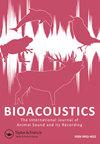来自地下的超声波:地下野生和圈养北方鼹鼠的秘密交流
IF 2.1
4区 生物学
Q2 ZOOLOGY
Bioacoustics-The International Journal of Animal Sound and Its Recording
Pub Date : 2021-08-03
DOI:10.1080/09524622.2021.1960191
引用次数: 6
摘要
摘要:这项研究首次证明了一种真正的地下啮齿动物——北方鼹鼠——的超声波发声。通过用诱饵吸引来电者进入洞穴入口来记录通话,研究人员在那里大多能看到来电者。通过与两只野生捕获的年轻雄性的USV以及与一个圈养群体的四只成年的USV进行比较,从俄罗斯南部14个不同洞穴记录的USV被证实属于talpinus Ellobius。作为探索USV多样性功能的第一次尝试,我们定义了最大基频(f0)为35.32±5.11 kHz的向上强USV和最大f0为31.40±7.78 kHz的可变微弱USV。与可变微弱USV相比,向上强USV更长,具有更大的频率调制深度,并且以规则序列的方式在高强度下产生。在野外,向上强烈的USV的最大频率和峰值频率低于人工饲养,而在野外和人工饲养的记录中,可变的微弱USV没有差异。我们讨论了在岩松Ellobius talpinus和地表生活的Arvicolinae物种的USV中发现的相似范围的声学变量,这并不支持地下生命显著减少啮齿动物超声波发声的假设。本文章由计算机程序翻译,如有差异,请以英文原文为准。
Ultrasound from underground: cryptic communication in subterranean wild-living and captive northern mole voles (Ellobius talpinus)
ABSTRACT This study provides the first evidence of ultrasonic vocalisations (USVs) in a truly subterranean rodent, the northern mole vole Ellobius talpinus. Calls were recorded by attracting callers with a bait to burrow entrances, where they were mostly visible to researchers. USVs recorded from 14 different burrows in southern Russia were verified as belonging to Ellobius talpinus by comparison with USVs of two wild-captured young males and by comparison with USVs of four adults from a captive colony. As a first attempt at exploring the function of USV diversity, we defined upward-intense USVs, with a maximum fundamental frequency (f0) of 35.32 ± 5.11 kHz, and variable-faint USVs, with a maximum f0 of 31.40 ± 7.78 kHz. Compared to variable-faint USVs, the upward-intense USVs were longer, had a larger depth of frequency modulation and were produced at high intensity in regular series. The upward-intense USVs were lower in the maximum and peak frequencies in the wild than in captivity, whereas the variable-faint USVs did not differ between recordings from the wild and from captivity. We discuss that similar ranges of acoustic variables found in USVs of Ellobius talpinus and surface-dwelling Arvicolinae species do not support the hypothesis that subterranean life has drastically reduced ultrasonic vocalisation in rodents.
求助全文
通过发布文献求助,成功后即可免费获取论文全文。
去求助
来源期刊
CiteScore
4.50
自引率
0.00%
发文量
25
审稿时长
>12 weeks
期刊介绍:
Bioacoustics primarily publishes high-quality original research papers and reviews on sound communication in birds, mammals, amphibians, reptiles, fish, insects and other invertebrates, including the following topics :
-Communication and related behaviour-
Sound production-
Hearing-
Ontogeny and learning-
Bioacoustics in taxonomy and systematics-
Impacts of noise-
Bioacoustics in environmental monitoring-
Identification techniques and applications-
Recording and analysis-
Equipment and techniques-
Ultrasound and infrasound-
Underwater sound-
Bioacoustical sound structures, patterns, variation and repertoires

 求助内容:
求助内容: 应助结果提醒方式:
应助结果提醒方式:


